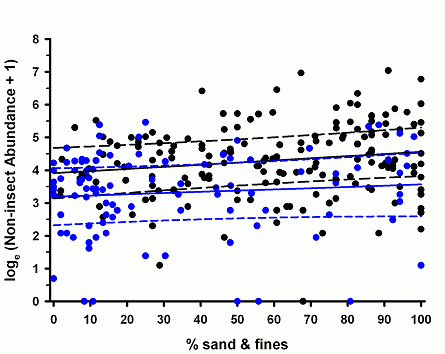Linear Regression: Non-insect Relative Abundance vs. Percent Sands and Fines for Minnesota Streams

Plot
- Analysis: Linear regression
- Independent variable: Percent (%) sand and fines
- Dependent variable: Non-insect abundance/m²
- Classification: Using Omernik level II Ecoregions with dummy variable = 0 for Ecoregions 46, 47, and 51 and dummy variable = 1 for Ecoregions 50 and 52.
- Key: symbols = observations, solid line = mean line, dashed line = 95% prediction limit, black lines and symbols = Ecoregions 46, 47 and 51, blue lines and symbols = Ecoregions 50 and 52
- Sample size: n = 267
Model
- Ecoregions 50 and 52: loge(Non-insect Abundance + 1) = 3.191 - 0.00375*(% sand & fines)
- Ecoregions 46, 47 and 51: loge(Non-insect Abundance + 1) = 3.909 - 0.00651*(% sand & fines)
- r² = 0.159
- Date: 6 October, 2006
| Variable | Estimate | t value | p |
|---|---|---|---|
| Intercept | 3.909 | 19.05 | |
| Ecoregion class | -0.718 | -2.71 | 0.007 |
| % Sand & fines | 0.00651 | 2.08 | 0.038 |
| % Sand & fines x Ecoregion class | -0.00276 | -0.57 | 0.57 |
Data Analysis
- Non-insect abundance was transformed by taking the natural log of abundance +1 for each observation.
- Model generated using SAS Proc GLM with the solution option. The 95% prediction limits were calculated using the equation in step 9 of box 14.3 from Sokal and Rohlf (1995). The intercept, slope, grand mean of % sand & fines, and corrected sums of squares were calculated using Proc REG and Proc UNIVARIATE.
- The ecoregions were aggregated into two classes because a preliminary ANOVA indicated that the base material for bedded sediments, % coarse substrates, was significantly greater in Ecoregions 50 and 52 than in Ecoregions 46, 47, and 51. Percent coarse substrates, however, did not significantly differ within either group.
- Replicate visits to a site were excluded from the data set.
Data Origin
- Agency: Minnesota Pollution Control Agency, St. Paul, Minnesota Exit
- Location: Minnesota - analyses restricted to wadeable sites (52 km² < watershed area < 523 km²) from the five ecoregions indicated below.
- Omernik Level III Ecoregions examined include: 46 (Northern Glaciated Plains), 47 (Western Corn Belt Plains), 50 (Northern Lakes and Forests), 51 (North Central Hardwoods), and 52 (Driftless Area).
Sampling Design
- Data collected 1996 through 2004.
- Sampling protocols: You may need a PDF reader to view some of the files on this page. See EPA’s About PDF page to learn more.
- Description of the sampling methods for invertebrates (PDF)
- Description of the sampling methods for measuring physical habitat characteristics, including % sand and fines (PDF)
- Description of invertebrate enumeration methods
Contact
Michael B. Griffith, griffith.michael@epa.gov, (513) 569-7034
